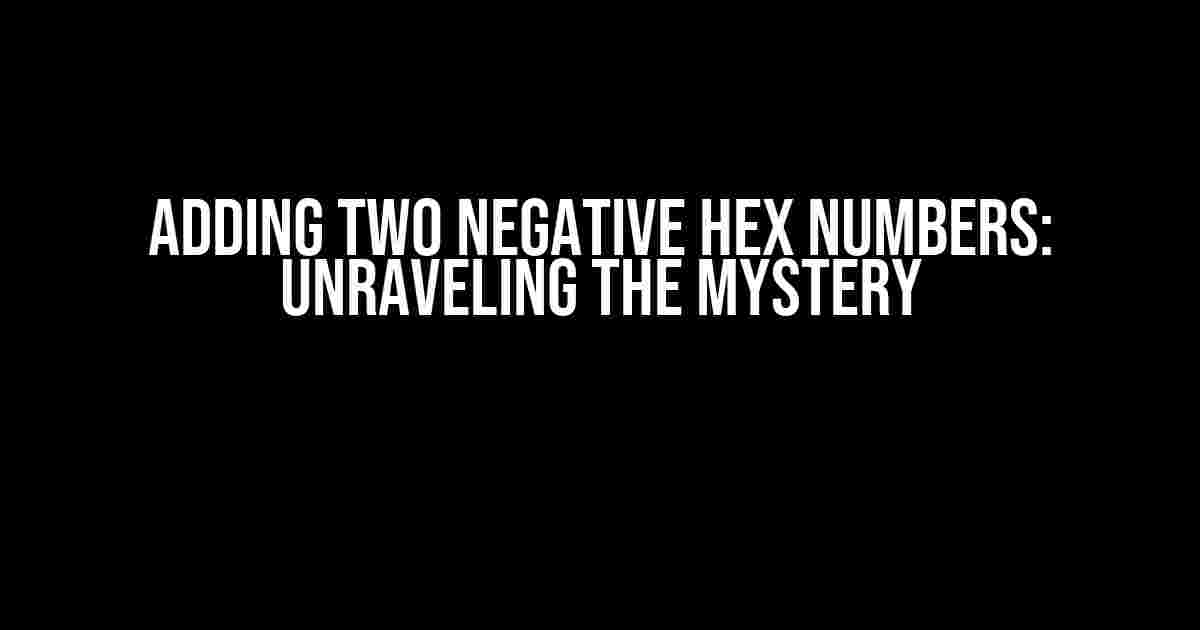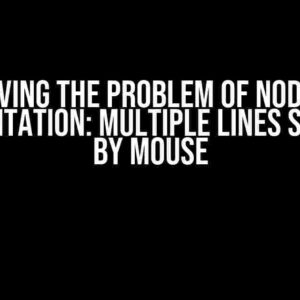Are you tired of getting lost in the hexadecimal realm when dealing with negative numbers? Fear not, dear reader, for today we embark on a thrilling adventure to demystify the art of adding two negative hex numbers!
What’s the Big Deal About Negative Hex Numbers?
You might be wondering, “Why the fuss about negative hex numbers?” Well, my friend, it’s because hexadecimal notation is a fundamental aspect of computer programming, and mastering it can make a significant difference in your coding skills. Negative hex numbers might seem intimidating, but trust me, with the right guidance, you’ll be adding them like a pro in no time!
Understanding Hexadecimal Notation
Before we dive into the nitty-gritty of adding negative hex numbers, let’s take a quick detour to refresh our memory on hexadecimal notation.
Hexadecimal notation uses 16 distinct symbols: 0 1 2 3 4 5 6 7 8 9 A B C D E F
These symbols represent decimal values from 0 to 15. Each hexadecimal digit can be converted to its decimal equivalent using the following table:
| Hexadecimal | Decimal |
|---|---|
| 0 | 0 |
| 1 | 1 |
| 2 | 2 |
| … | … |
| A | 10 |
| B | 11 |
| C | 12 |
| D | 13 |
| E | 14 |
| F | 15 |
Now that we’ve got the basics covered, let’s tackle the main event – adding two negative hex numbers!
Step-by-Step Guide to Adding Two Negative Hex Numbers
Here’s a simple, foolproof method to add two negative hex numbers:
-
Convert both negative hex numbers to their decimal equivalents using the table above.
-
Add the decimal equivalents as you would with regular decimal numbers.
-
Convert the resulting decimal value back to its hexadecimal equivalent.
-
If the result is a positive hex number, add a minus sign (-) before the hexadecimal value.
Example 1: Adding Two Negative Hex Numbers
Let’s add -0xA (negative 10 in decimal) and -0xB (negative 11 in decimal).
-0xA (hex) = -10 (decimal) -0xB (hex) = -11 (decimal) Add the decimal values: -10 + (-11) = -21 Convert the result to hex: -21 (decimal) = -0x15 (hex)
Therefore, the result of adding -0xA and -0xB is -0x15.
Example 2: Another Scenario
Now, let’s add -0xF0 (negative 240 in decimal) and -0x10 (negative 16 in decimal).
-0xF0 (hex) = -240 (decimal) -0x10 (hex) = -16 (decimal) Add the decimal values: -240 + (-16) = -256 Convert the result to hex: -256 (decimal) = -0x100 (hex)
Therefore, the result of adding -0xF0 and -0x10 is -0x100.
Common Pitfalls to Avoid
When adding two negative hex numbers, it’s essential to keep the following in mind:
-
Never add the hex values directly. Convert them to decimal equivalents first.
-
Be careful when converting the result back to hex. Make sure to include the minus sign (-) if the result is negative.
-
Double-check your calculations to avoid errors.
Practicing What We Preach
Now that we’ve covered the theory and seen some examples, it’s time to practice! Try adding the following negative hex numbers:
-0x2A and -0x13 -0x50 and -0x20 -0x1F and -0x9
Take your time, and remember to follow the steps outlined above. Once you’ve got the answers, check them against the solutions below:
-0x2A + (-0x13) = -0x3D -0x50 + (-0x20) = -0x70 -0x1F + (-0x9) = -0x28
Conclusion
Adding two negative hex numbers may seem daunting at first, but with the right approach, it becomes a breeze! By following the step-by-step guide and avoiding common pitfalls, you’ll be well on your way to mastering hexadecimal arithmetic.
Remember, practice makes perfect. Continue to challenge yourself with different negative hex numbers and soon you’ll be a pro at adding them with ease.
Happy coding, and may the hex be with you!
Frequently Asked Question
Get ready to ace the art of adding two negative hex numbers with our FAQs!
What’s the deal with adding two negative hex numbers? Does it even make sense?
Absolutely! Adding two negative hex numbers is a valid operation, and it follows the same rules as adding two negative numbers in decimal. Just remember to convert the hex numbers to decimal, add them, and then convert the result back to hex.
How do I convert a negative hex number to decimal?
Easy peasy! To convert a negative hex number to decimal, simply remove the negative sign, convert the hex number to decimal, and then add the negative sign back to the result. For example, -0xA would become A, which is 10 in decimal, and then you’d add the negative sign back to get -10.
What if the result of adding two negative hex numbers is still negative? Do I keep the negative sign?
You bet! If the result of adding two negative hex numbers is still negative, you should definitely keep the negative sign. Remember, when you’re working with negative numbers, the result will always have the same sign as the original numbers. So, if you’re adding two negative hex numbers, the result will always be negative.
Can I use a calculator to add two negative hex numbers?
Why not?! Yes, you can definitely use a calculator to add two negative hex numbers. Just make sure to set your calculator to hex mode, enter the two negative hex numbers, and let the calculator do the magic. You can also use online hex calculators or programming languages like Python to make it even easier.
Is adding two negative hex numbers used in real-life applications?
You’d be surprised! Adding two negative hex numbers is used in various areas like computer graphics, game development, and even cryptography. For example, in computer graphics, you might need to add two negative hex numbers to calculate the position of an object on the screen. So, next time you’re playing a game or using a graphics editor, remember that adding two negative hex numbers might be happening behind the scenes!




